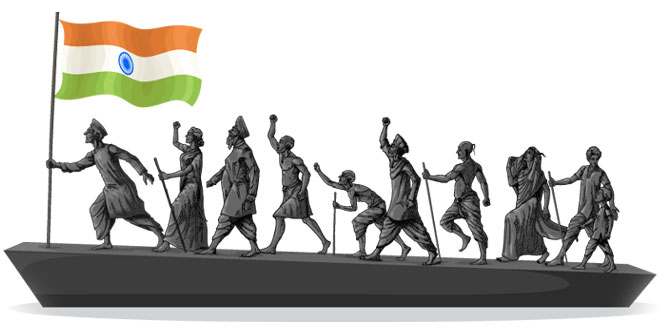Question: What methods did the revolutionaries adopt to liberate India from the British? What was the British response?
Answer: The early years of the twentieth century saw the growth of the a revolutionary movement in Bengal, Punjab and Maharashtra. Young advocated the use of the force to expel the British from India. They formed secret societies to train their members in the use of firearms and explosives. Two of the most active revolutionary societies were the Abhinava Bharat Society in Maharashtra and the Anushilan Samiti in Bengal.
They took to assassinating British officials. The Chapekar brothers assassinated two unpopular British officials in Maharashtra. In 1980, in Muzaffarpur (Bihar), Khudiram Bose and Prafulla Chaki threw bomb at Kingsford, the district judge. In 1912, an attempt was made on the life of Viceroy Lord Hardinge.
Some revolutionaries were also active abroad, especially in Europe and America. The Ghadar Party was a revolutionary association. It published journals (one of them was Ghadar) to spread revolutionary Ideas. It also sent revolutionaries to organize uprisings in India.
Question: Write short notes on-Role of the press in arousing national Consciousness, The Swadeshi and Boycott Movement.
Answer: Role of the press in arousing national consciousness: The Indian press played an extremely important role in strengthening national consciousness. The newspapers of the period highlighted the anti-Indian policies of the British government and asked the people to unite and work for a common cause. Both the English and the vernacular press became a medium to mobilize public opinion and create a feeling of national bonding. The government tried to suppress the growing feeling of nationalism and patriotism by banning newspapers and books. These attempts, however, failed. The work of scholars and writers like Bankim Chandra Chatterjee, Rabindranath Tagore, Subramania Bharati, Bhartendu Harishchandra and others were also important in arousing national consciousness.
The Swadeshi and Boycott Movement: The partition of Bengal gave rise to two new method of struggle – Swadeshi and boycott. Swadeshi means ‘of one’s own country’. It was aimed at popularizing goods manufactured in India so that Indian industries could prosper. The method of boycott focused on asking people to boycott goods manufactured in Britain. Starting from Bengal, the movements spread across the country. At some places, huge bonfires of foreign cloths were organized. People who wore cloths made from cloths manufactured in Britain were criticized. Some washermen even refused to offer their service to such people. Students and women played a very important role in these movements. They picketed shops selling foreign goods.
Question: What is the literal meaning of sarvajanik?
Answer: The literal meaning of sarvajanik is ‘of or for all the people’. It is made of two words: sarva = all + janik = of the people.
Question: Who was A.O. Hume? What role did he play in the history of India?
Answer: A.O. Hume was a retired British official. He played an important role in bringing Indians from the various regions together.
Question: Who was the Viceroy of India at the time of the partition of Bengal
Answer: At that time Lord Curzon was the Viceroy of India.
Question: What was the Swadeshi Movement known as in deltaic Andhra?
Answer: In deltaic Andhra the Swadeshi Movement was known as the Vandemataram Movement.
Question: Name the three leading members of the Radical group.
Answer: Bepin Chandra Pal, Balgangadhar Tilak and Lala Lajpat Rai.
Question: Why did Mahatma Gandhi along with other Indians establish the Natal Congress in South Africa?
Answer: He did so in order to fight against racial discrimination in South Africa.
Question: Name three places where Gandhiji started local movements.
Answer: Champaran, Kheda and Ahmedabad.
Question: Why did Rabindranath Tagore renounce his knighthood?
Answer: Rabindranath Tagore renounced his knighthood to express the pain and anger of the country following the Jallianwala Bagh atrocities.
 Class Notes NCERT Solutions for CBSE Students
Class Notes NCERT Solutions for CBSE Students



Pura book hi chap thya hai
Sala fake
Please don’t paste the nude advertising. Many times complained for this. But no solutions….
The advertisements are provided by Google depending on cookies or last search made on your computer or smartphone. Please clean your cache, these will stop appearing. It’s not our hand. – Admin